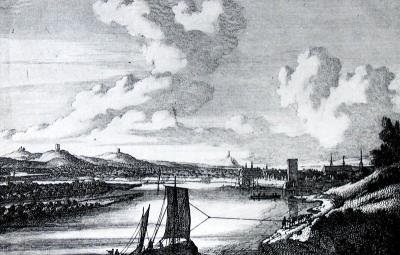Going by Ship - SANDRA SCHWAB | Historical Romance Author
Main menu:
- Welcome
-
Bookshelf
- Eagle's Honor
- Allan's Miscellany
- A Love for Every Season
- Stand-alone Novels
- About Sandra
- Research
- Author Services
- Contact
- Blog
Going by Ship
Travels on the Rhine: Enter the British Tourist | About Guidebooks | Murray's Handbook | Going by Ship
Navigating ships on the Rhine, though, was a little bit difficult: down the Rhine you could make the best of your sails, of course, but up the Rhine ships had to be trailed by either horses or sometimes by men. For a journey from Mainz to Cologne you needed 2 days. For the journey back you needed three, and during the autumn and winter you needed 3 to four days. And, of course, journey might be prolonged or even interrupted due to the weather conditions.

Since the 17th century, the conveyance of passengers had become increasingly comfortable: the so-called "Wasserdiligencen" offered food and drink, and sometimes you could even spend the night on board. More importantly, the passenger room was heated during the winter. Some people would also buy a smaller and faster ship for the duration of their journey or they'd decide to go along on one of the marketships -- this was the cheapest form of travelling on the Rhine: in the 18th century you paid 3 talers for the whole passage Mainz-Cologne, whereas on a diligence you had to pay 27 talers just for the Mainz-Coblenz passage.
When the French occupied the Rhine, they introduced a waterpost between Mainz and Cologne. From March till November the mailboats departed daily; during the winter months only three times a week. Each passenger could take 25 kilos of luggage on board and had to pay for any excess -- very much like travelling by plane today.
Steamships were introduced in the mid 1820s: the first regular route was Rotterdam-Cologne, which was established in 1824. Several more routes followed, the most important being Cologne-Mainz. Steamship-travel on this route was organized by the Preußisch-Rheinische-Gesellschaft (the Prussian-Rhenish-Association). In 1827 two ships per week drove back and forth on the Rhine. Down the Rhine you now needed only 10 hours; up the Rhine it were still 2 days.
~*~
And here're some more verses from Byron's Childe Harold to end this section in style:
"Adieu to thee, fair Rhine! How long delighted
The stranger fain would linger on his way!
. . . . . . . . . . . . . . . . . . . . . . . . . . . .
Adieu to thee again! a vain adieu!
There can be no farewell to scene like thine;
The mind is colour'd by thy every hue;
And if reluctantly the eyes resign
Their cherished gaze upon thee, lovely Rhine!
'Tis with the thankful heart of parting praise;
More mighty spots may rise, more glaring shine,
But none unite in one attaching maze
The brilliant, fair, and soft, – the glories of old days."
Travels on the Rhine: Enter the British Tourist | About Guidebooks | Murray's Handbook | Going by Ship